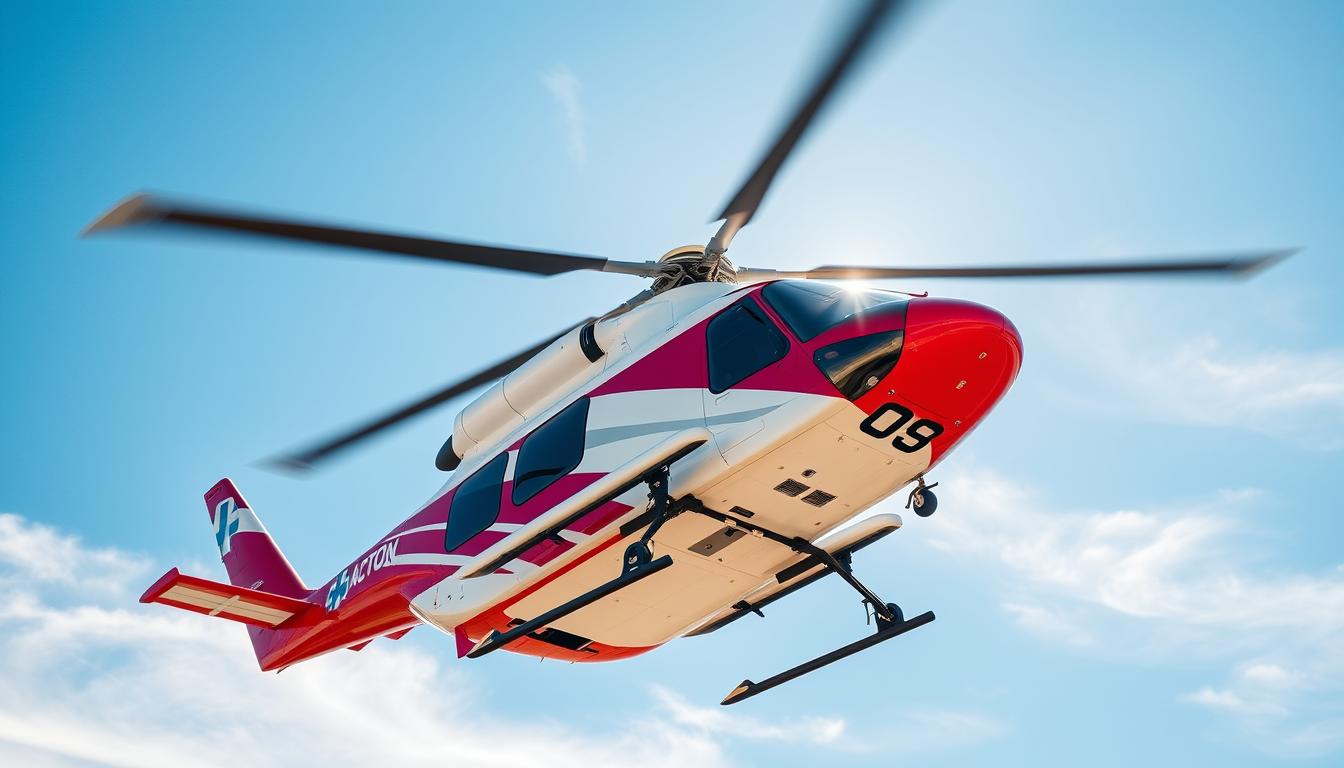Air Ambulance Helicopter missions save lives by closing time gaps between incident and definitive care.
These operations combine aviation speed with clinical expertise to deliver rapid critical care during trauma, stroke, and other time-sensitive events.
Teams carry ventilators, monitoring units, medications, and stretchers so treatment begins en route. Crews follow strict protocols and receive priority handling under MEDEVAC call signs.
This overview explains how on‑board systems, crew makeup, and platform choice affect outcomes. It covers commonly used models and where fixed‑wing integration fits for longer transfers.
Readers can learn how deployment decisions expand rural coverage, reduce delays, and maintain continuity of care from dispatch to hospital handoff. For detailed model classifications see types and models, and for pilot challenges in tough conditions consult this resource on operational risks: pilot challenges.
Key Takeaways
- Rapid transport links patients to definitive care when minutes matter.
- Crewed missions carry advanced monitoring and life‑support equipment.
- Platform choice influences mission range, weather tolerance, and capacity.
- Standardized protocols reduce delays from dispatch to handoff.
- Understanding capabilities helps hospitals and families evaluate providers.
Air Ambulance Helicopter Services In The United States
Specialized rotor teams link rural patients to trauma and specialty centers far sooner than ground response alone. Rapid deployment reduces the interval to definitive care for stroke, major trauma, and cardiac events where minutes change outcomes.
Rapid Access To Emergency Care And Time-Sensitive Transport
Programs operate seven days a week with an integrated crew of pilot, flight nurse, and flight paramedic ready for scene response or transfers. Priority handling under MEDEVAC call signs shortens routing and handoff time to receiving hospitals.
When To Deploy Air Medical Transport For Patients
Deployment relies on clear triage protocols that balance clinical urgency, weather, and distance to Level I centers. This guidance helps avoid unnecessary launches while ensuring high‑acuity patients move quickly to the right facility.
Extending Care To Rural Areas Through Strategic Bases
For example, a major regional operator maintains more than 150 bases across 15 states, with over 90% positioned in rural communities and roughly 84% of transports originating outside urban areas. These networks expand access where ground trips would add critical delay.
“Integrated dispatch and standardized activation reduce on-scene delays and improve patient continuity from pickup to hospital handoff.”
- Benefit: Faster transport to specialty teams and technology.
- Team: Clinicians provide advanced stabilization en route.
- Coverage: Strategic bases close gaps across wide service areas.
Learn how a leading operator positions resources by visiting regional operator and review comparisons of air vs ground response at when air transport is critical.
Critical Features That Power Life-Saving Air Medical Transport
Critical onboard systems combine ICU‑grade gear and streamlined workflows to keep patients stable during rapid medical transport. These capabilities define whether clinicians can deliver definitive interventions while en route.

Onboard Medical Equipment, Monitoring, And Critical Care Capability
Medical platforms carry ventilators, infusion pumps, advanced monitors with ECG and capnography, airway kits, resuscitation equipment, and a compact pharmacy. Redundant power and oxygen systems ensure therapies continue during longer missions.
Standard configurations support invasive ventilation, cardiac rhythm care, and pain or sedation protocols. Checklists and fixed equipment layouts cut cognitive load and speed interventions in tight cabins.
Clinical Teams, Flight Crew Composition, And Care Protocols
Typical crews include a pilot plus a flight nurse and a flight paramedic who share ICU experience and prehospital agility. Protocol‑driven decision making guides airway work, hemodynamic support, and medication delivery.
- Communication: Integrated radios and data links send prearrival information to receiving hospitals and enable consults.
- Priority: ATC MEDEVAC call signs minimize routing delays so receiving teams can prepare.
- Safety: Environmental checks, weight‑and‑balance, and crew resource management let any member cancel a mission if conditions threaten safety.
“Clear protocols and ICU‑grade equipment preserve continuity of care from scene to specialty centers.”
For in‑depth clinical guidance and recent technology improvements, see the critical care transport review and the overview of technology advancements.
Top Helicopter And Aircraft Models For Medical Transportation
Selecting the right model hinges on matching payload, range, and clinical workflow to mission needs. Teams should compare cabin layout, performance at altitude, and maintenance support when assigning aircraft to particular routes and bases.

EC145/EC 145: Versatile Cabin Space For Trauma And Interfacility Flights
The EC145 is widely used in civilian rescue services for good reason. Its spacious cabin supports full critical care setups and lets clinicians access the stretcher from multiple sides.
Best for: trauma scene work and short interfacility transport where cabin ergonomics matter.
AW139: Speed, Range, And Safety Enhancements For Longer Missions
The AW139 delivers higher cruise speeds and longer range. Programs such as ORNGE use it for extended transfers and missions over water.
Best for: longer-distance assignments where time and distance constraints dominate planning. See a model comparison for pilots and operators here.
Bell 412 And Bell 429: Reliability For Diverse Mission Profiles
Bell 412 and 429 airframes are known for reliability and mission flexibility. They scale well from scene response to interfacility moves and handle varied geography and helipad sizes.
Fixed-Wing Integration For Long-Distance Patient Transport
Fixed-wing aircraft extend reach for long-haul repatriation and transfers. They offer pressurization, weather resilience, and space for multiple caregivers and extra equipment.
Best for: multi-hour transfers and voyages where rotor operations face range or weather limits. For model specifications used in EMS programs, review manufacturer materials such as the S‑76 EMS brochure spec sheet.
| Model | Strengths | Typical Use |
|---|---|---|
| EC145 | Spacious cabin, configurable layout, clinician access | Trauma, short interfacility transport |
| AW139 | Higher cruise speed, extended range, safety features | Longer missions, regional transfers |
| Bell 412 / 429 | Proven reliability, adaptable airframe, stable flight | Scene response, varied geography operations |
| Fixed-Wing | Pressurized cabin, weather resilience, long range | Long-distance medical transport and repatriation |
“Matching platform trade-offs—cabin volume, power margins, and endurance—ensures assets fit the intended service profile.”
Safety, Operations, And Service Footprint
Integrated safety systems, from preflight hazard scoring to post-incident support, form the backbone of reliable emergency transportation services.
Operational governance blends aviation best practices with clinical risk management. Preflight risk checks, weather minima, and crew resource management keep the patient and team protected.

Safety Governance, Incident Response, And Crew Well-Being
Governance embeds clear activation and cancelation criteria. Operational playbooks address higher-risk factors like night operations, adverse weather, and post-crash fire hazards.
When an Missoula-based aircraft and crew (LF 88) had an accident near Lincoln, Montana at about 1:10 a.m. MDT, no patient was onboard and no injuries occurred. The operator cooperated with authorities and prioritized crew well‑being with mental and physical health resources.
- People First: Incident protocols focus on crew recovery before mission review.
- Just Culture: The “3 to go, 1 to say no” principle lets any member abort launch without fear.
- Strategic Footprint: More than 150 bases in 15 states reduce mission distance and exposure, especially in rural areas.
- Training & Metrics: Simulation, proficiency checks, and safety tracking sustain readiness for low-frequency, high-acuity events.
“Clear standards and transparent reporting protect life at every moment of the mission.”
Conclusion
Well‑matched platforms, crews, and protocols turn every launch into predictable, high‑quality care. , Teams that combine proven clinical capability with reliable equipment shorten time to definitive treatment and boost survival odds.
The operating model gives a patient priority routing and staffed cabins that support ventilation, monitoring, and resuscitation. Integrated dispatch and trained clinicians keep the focus on stability throughout each flight.
Selection should favor providers with documented clinical outcomes and solid operational governance. Readers can review a key survival study and a summary of pilot experience in EMS programs at pilot experience summary to compare systems.
When readiness, standardization, and communication align, each flight protects life at the most vulnerable moment and makes measurable gains in trauma and critical care.
FAQ
What does an air medical transport service provide?
An air medical transport service provides rapid patient movement and advanced clinical care during flight. Teams include critical care clinicians and pilots who operate purpose-built aircraft equipped with monitoring, ventilators, and life-support systems to stabilize patients en route to definitive care.
When is air medical transport deployed instead of ground transport?
Air medical transport is chosen for time-sensitive emergencies, remote incidents, or when ground travel would significantly delay definitive care. Medical control, emergency physicians, or receiving hospitals typically authorize deployment based on clinical urgency and transport time savings.
How do providers extend care to rural and hard-to-reach areas?
Providers position strategically located bases and coordinate with local EMS to reduce response times. They use helicopters and fixed-wing aircraft to bridge distances, deliver critical interventions on scene, and transfer patients to specialized centers unavailable locally.
What onboard equipment supports critical care during flight?
Aircraft carry advanced monitors, portable ventilators, infusion pumps, cardiac defibrillators, and blood products when needed. Equipment selection emphasizes compact, secure, and aviation-certified devices to maintain high-level care without compromising safety.
Who composes a typical flight clinical team?
A typical team includes a flight nurse and flight paramedic, and often a flight physician or respiratory therapist for high-acuity cases. Crews train together on protocols, airway management, and in-flight medication administration to ensure consistent clinical decisions.
What safety measures govern medical flight operations?
Safety measures include strict maintenance schedules, crew resource management training, weather minimums, and regulatory oversight from the FAA and healthcare accrediting bodies. Programs also conduct routine safety audits and simulation training to reduce operational risk.
How do different aircraft models affect mission capability?
Aircraft choice impacts cabin space, speed, range, and payload. Models with larger cabins allow more equipment and team access for complex care, while faster platforms extend reach. Fixed-wing aircraft serve long-distance transfers, whereas rotorcraft excel at scene response and short hops.
What are the advantages of the EC145/EC 145 for patient transport?
The EC145/EC 145 offers a spacious cabin that accommodates critical care stretchers and multiple clinicians. Its design supports rapid loading, good visibility for flight crews, and adaptability for trauma and interfacility transfers.
Why is the AW139 favored for longer missions?
The AW139 delivers greater speed and range, along with redundant systems and safety enhancements suited for extended flights. These characteristics reduce travel time to tertiary centers and increase mission flexibility across larger service footprints.
What do Bell 412 and Bell 429 models offer operators?
Bell 412 and Bell 429 models are known for operational reliability and versatile configurations. They balance performance with maintainability, supporting diverse mission profiles from scene response to hospital-to-hospital transfers.
When is fixed-wing integration necessary?
Fixed-wing integration becomes necessary for long-distance transfers, inter-state repatriation, or when weather and conditions favor runways over landing zones. Fixed-wing platforms provide longer range, higher cruise speeds, and cabin environments suited for prolonged critical care.
How are incidents and crew well-being managed after adverse events?
Programs implement incident response plans, root-cause analysis, and peer support systems. Crews receive psychological support, debriefing, and training updates to address human factors and to preserve operational readiness and mental health.
How do organizations measure their service footprint and response effectiveness?
Organizations track response times, mission outcomes, and coverage maps to assess footprint. They use data on dispatch-to-scene intervals, transport duration, and patient outcomes to optimize base locations and resource allocation.
Related Articles
- Medical Transport Helicopters: Critical Features and Models for Emergency Flights
- Helicopter Drones: The Future of Unmanned Aerial Systems
- Helicopters for Offshore Oil and Gas Operations: Transporting Workers and Equipment
- Helicopters in Tourism: The Best Models for Scenic Tours
- Helicopters for Police and Law Enforcement: Surveillance and Patrol Capabilities
More from This Category
- The Evolution of Attack Helicopters: Key Models and Their Capabilities
- Utility Helicopters: The Workhorses of the Sky
- Trainer Helicopters: The Best Models for Learning to Fly
- Helicopters for Aerial Photography and Filmmaking: Top Picks for Capturing the Perfect Shot
- Luxury Helicopters: The Best Models for Private and Corporate Use
- Heavy Lift Helicopters: Moving Large Cargo and Equipment
- Agricultural Helicopters: Aerial Spraying and Crop Management
- Rescue and EMS Helicopters: How They Save Lives in Critical Situations
- Military Helicopters: Key Models and Their Combat Roles
- The Different Types of Helicopters: From Light Utility to Heavy Lift



